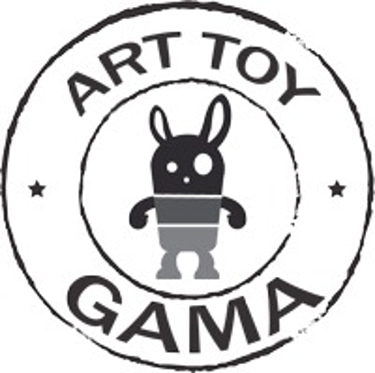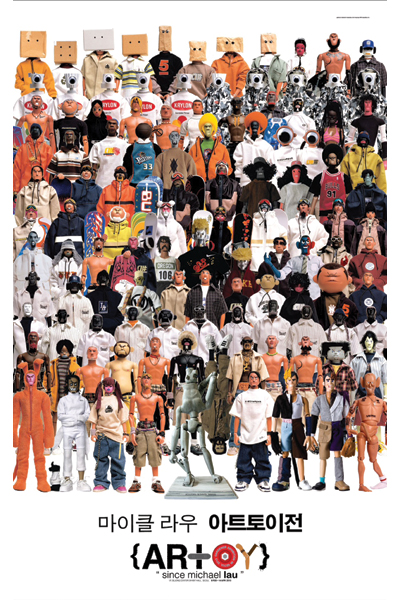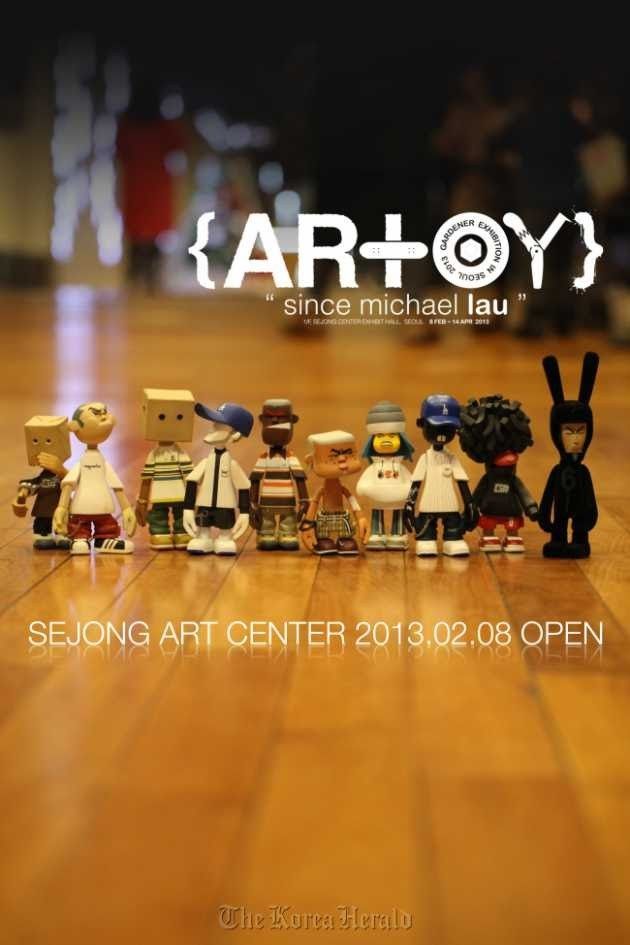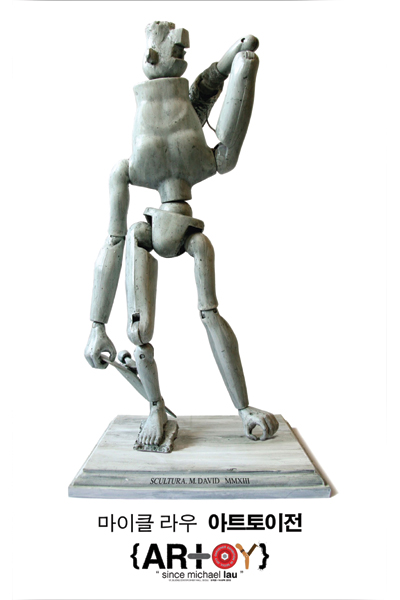We didn’t lose our inner child. We turned it into ArT Toys and More...with purpose.
🎭 {AR+OY} Since Michael Lau — Sejong Art Center, 2013
{AR+OY} Since Michael Lau: When vinyl lined up like a tribe and stared back at the Museum — Sejong Art Center, Korea, 2013 #00009 — TNoTToys Publications
TNOTTOYS PUBLICATIONS1000 ICONIC ART TOY EXHIBITIONS
Sergio Pampiega Campo & Cristina A. del Chicca
🌀 This post is part of an ongoing research series from Art Toy Gama’s editorial division:
📚 This Is Not a Book About Art Toy Exhibitions & ToyCons
Our Upcoming Art Toy Book: 1000 Iconic ArTToy Exhibitions
✧ Context: When the Institution Meets the Street
Seoul, 2013.
Not in a Toy shop.
Not in a pop-up.
In the Sejong Center for the Performing Arts,
the cultural heart of the city,
the institutional spine of South Korea.
A landmark built for opera, ballet, classical music, national ceremony.
A place where culture is not consumed,
it is canonized.
And into that polished temple,
Michael Lau walked in with a tribe of vinyl bodies
born from hip-hop, graffiti, skate,
Hong Kong pavement,
youth culture electricity.
The choice of venue was not neutral.
It was declaration.
Official Legitimization
By hosting {AR+OY}, the Sejong Center did more than lend space,
it conferred status.
ArT Toys stepped out of the niche
and onto the main stage of Asian cultural Identity.
This was Not a collector’s Show.
Not a comic fair.
It was institutional acknowledgment:
the ArT Toy belongs to the cultural record.
A Clash of Codes
Street vs. stage.
Graffiti silhouettes under museum lights.
Vinyl swagger where opera once echoed.
Lau’s Gardeners did not adapt to the institution.
They invaded it.
The POSTER’s wall of faces makes sense here:
it is not a pattern,
it is occupation.
A full visual takeover of a space that had never held such bodies before.
Korea in 2013
South Korea was rising as a global cultural force…
K-pop, Hallyu, technological innovation, aesthetic futurism.
Inviting Lau was a signal:
the nation was ready to integrate the languages of global youth culture,
street style,
and Designer Toys
into its evolving artistic Identity.
The POSTER as Institutional Insurgence
Seen through the lens of Sejong’s prestige,
the POSTER becomes more than crowd.
It is a cultural march.
A declaration that the street no longer waits outside the museum,
it enters,
fills the hall,
and rewrites the terms.
The tribe has reached the City’s Center.
And it is claiming its place in official Memory.
POSTER Reading
A wall of faces.
A crowd of stares.
The poster of {AR+OY} doesn’t show one figure, it shows an army.
133 characters, shoulder to shoulder,
each different,
each carrying its own mood.
Hip-hop hoodies, basketball jerseys, cardboard heads, work suits, braids, masks, sneakers.
The composition builds a dense pattern:
repetition that becomes rhythm,
a multitude that turns into Identity.
The palette is restrained: earthy browns, blacks, whites, muted oranges,
with rare bursts of vivid tones.
It feels like streetwear translated into ink:
neutral enough to unify,
bold enough to mark difference.
Typography is clean, almost surgical.
{AR+OY} framed by brackets, like a code, a formula:
Art plus Toy fused into one word.
The “O” bears a red bullseye: a target.
The “Y” stretches into lines, evoking a slingshot.
Together, they suggest tension:
aim and release,
focus and disruption.
A sign that this Movement doesn’t sit still.
It lands.
Above, Korean script locates the show in Seoul.
Lau’s world of vinyl no longer an import,
but something adopted into the cultural vocabulary of Korea.
The POSTER is Manifesto.
It doesn’t sell, it declares.
Each Gardener, with unique stance and outfit,
builds a collective face of a generation.
The message is simple but vast:
You’re not alone here.
There’s a whole tribe waiting for You.
✧ POSTER Reading: The Unseen Story
When a POSTER Stops Being Layout and Becomes Crowd
What {AR+OY} tells without saying is louder than any tagline.
It speaks in bodies.
In clothing codes.
In posture as language.
This is Not a gallery POSTER .
It is a census.
A documentation of a culture before it had a museum to house it.
A hundred-plus figures forming a single organism,
street culture as mythology,
Identity as multiplicity,
community as structure.
Nothing is centered.
There is no hero.
No hierarchy.
This is postmodern democracy in vinyl form.
The POSTER declares that the ArT Toy is not an object,
it is a population.
A living archive of style,
attitude,
gesture,
narrative.
Where classical Posters elevate one artwork,
this one elevates the many.
It breaks the tradition of artistic singularity
and replaces it with collective mythology.
It tells us the future of the ArT Toy Movement will not be led by one icon,
but by tribes.
By worlds.
By ecosystems of characters.
It is not a POSTER ,
it is sociology rendered in plastic.
✧ The POSTER’s Hidden Architecture
The composition of {AR+OY} operates like a visual engine.
What appears at first as a crowd portrait reveals itself, on closer reading, as a structural manifesto.
The Wall Effect: Figures as Pattern, Not People
The arrangement of characters rejects the conventional hierarchy of POSTER design.
No perspective. No depth. No staged focus.
Just a vertical and horizontal stacking of 133 Gardeners until they form a solid wall of presence,
a surface of identity so dense it becomes texture.
There is no “background” to retreat into.
Your eye is forced to read the whole as a tribal pattern.
Repetition becomes rhythm.
Multiplicity becomes message.
By removing depth, the POSTER eliminates spatial hierarchy.
No hero. No center. No chosen one.
The statement is blunt:
the Movement is the whole, not the individual.
A visual democracy made of bodies.
The Body as Text: Standardization vs. Identity
Under the clothing, nearly all figures share the same masculine base body.
The same upright stance.
The same Toy, like neutrality.
Mass production as skeleton.
But the outfits, the braids, the masks, the jerseys, the streetwear codes,
break the uniformity and assert individual Identity.
Cultural expression layered onto industrial repetition.
This tension is Michael Lau’s philosophy:
mass culture as the canvas,
personal culture as the intervention.
And the gaze seals the argument.
Almost every figure that has eyes
is looking straight at the viewer,
not at each other, not at the gallery.
A unified stare.
A collective address.
Not aggressive, but asserting presence:
“We’re here. Where are You?”
The White Void: Museum Without Walls
The figures float against a stark white backdrop,
not the white of packaging,
but the white of institutional space.
No shadows.
No environmental clues.
Nothing tying them to street corners, skateparks, or Hong Kong alleys.
By erasing context, the POSTER grants the figures museum seriousness.
It relocates the cultural meaning from place
to body.
This white void becomes the blank stage of the institution,
emptiness that the tribe now fills
and overpowers
simply by existing.
It reads like a message to the Art world:
You’re not bringing us into the museum.
We are taking the museum over.
The POSTER becomes a curatorial Act in itself,
a formalization of the Movement without sanitizing its roots.
An underground that walks into the institution
with its stance intact.
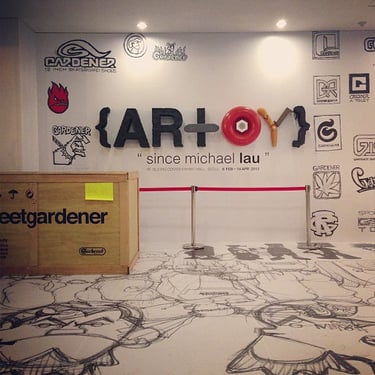
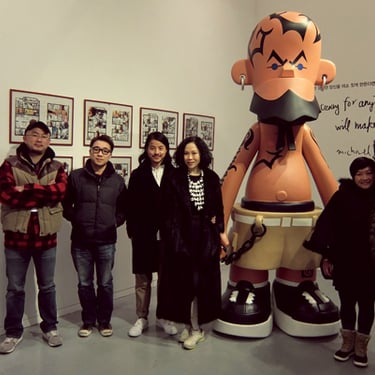
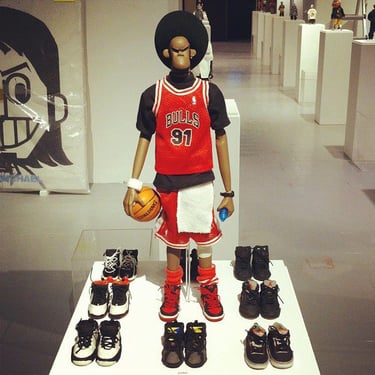
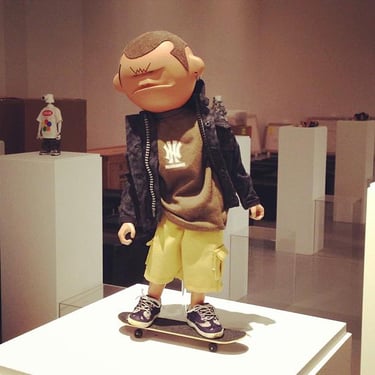
✧ The Central Figure: Archetype in the Crowd
In the middle of the crowd, one body breaks the pattern.
No hoodie.
No jersey.
No mask.
A pale, articulated figure,
grey, almost wooden,
like a classic artist’s mannequin pulled out of a studio and dropped into the tribe.
It looks wrong at first.
Too bare.
Too unfinished.
And that is exactly why it matters.
The Naked Homunculus
While the 132 surrounding Gardeners are pure identity,
streetwear, gesture, hairstyle, attitude,
this central figure is stripped of all of that.
No face.
No colour.
Just joints, limbs, and structure.
It’s the form in its most primitive state.
The skeleton of the Movement.
It points straight back to Art history:
those wooden mannequins painters and sculptors used to study pose and anatomy.
By inserting this “study tool” into the middle of his vinyl tribe,
Lau connects {AR+OY} directly to classical sculpture and studio practice.
This isn’t another character.
It’s the base body.
The platform before personality.
The seed from which the other 132 identities grow.
SCULPTURA. M.DAVID. MMXIII
On the plinth of the isolated sculpture, one line changes everything:
SCULPTURA. M.DAVID. MMXIII.
“M. DAVID” is not subtle.
It’s a wink and a challenge to Michelangelo’s David ,
the pinnacle of Western sculpture,
the ideal body of the Renaissance.
Lau takes the humble articulated mannequin
and names it after one of the most revered statues in history.
This is Not parody.
It’s repositioning.
He’s saying:
this is our contemporary David.
This is the body our era studies, poses, photographs, collects.
The ArT Toy is not a lesser echo of classical sculpture.
It is its postmodern reincarnation,
the way today’s world thinks about anatomy, gesture, pose, attitude.
The streets get the marble treatment.
A Pose in Progress
The figure isn’t standing in a calm contrapposto.
It’s caught mid-gesture:
one arm raised,
one leg planted,
a body that feels like it’s about to move,
or about to hold something.
Mannequins are supposed to be neutral.
This one isn’t.
By freezing the “model” in such a dynamic pose,
Lau turns the study tool into performance.
The body becomes language…
movement as syntax,
pose as sentence.
It’s as if street culture itself is being sculpted in real time,
captured mid-action rather than in heroic stillness.
This central figure is Lau’s metalinguistic Manifesto.
It explains the entire Show without a single word:
where Art (classical sculpture, the artist’s studio, the David)
meets Toy (the articulated figure, the production base, the platform),
and together they generate a new species:
the ArT Toy as the contemporary body of our era:
studied, posed, dressed, collected,
and remembered.
✧ Energy Behind The POSTER
The Pulse of a Movement Realizing Its Own Scale
The emotional current behind the {AR+OY} POSTER is tidal.
A surge of presence.
A wave of bodies claiming visibility.
It projects a specific kind of energy:
not commercial,
not nostalgic,
not cute,
cultural.
Identity
Each figure is a fragment of a larger portrait.
Identity here is plural,
a spectrum stitched into formation.
Memory
You feel the late ’90s and early 2000s:
magazines, mixtapes, basketball courts,
Hong Kong street heat.
Memory built from lifestyle, not nostalgia.
Legacy
The POSTER acts like a genealogical tree of urban aesthetics.
A reminder that Lau didn’t just design characters,
he designed a visual record of a generation.
Rebellion
Its density is intentional.
Its chaos is curated.
Its refusal to isolate a hero is a strike against traditional art hierarchy.
It rejects minimalism,
rejects elitism,
rejects silence.
It says:
“If you want to understand us, you have to face all of us.”
This is a POSTER that behaves like a room full of people.
It overwhelms on purpose.
It invites you to get lost in it,
and found in it.
Its energy is communal,
polyphonic,
alive.
A POSTER that doesn’t illustrate a Movement,
it embodies it.
What the Exhibition Showed
Inside Sejong Art Center, the promise of the POSTER unfolded.
1,000 pieces: sketches, drawings, paintings, collaborations, and Lau’s Gardener series.
Every piece revealed process.
From East Touch comic strips to vinyl icons, the line was visible.
The figures carried codes of hip-hop, skate, graffiti, sport, dance…
life compressed into body language, outfits, and glances.
And Lau himself was present.
Signing, talking, meeting eyes.
It wasn’t a cold retrospective.
It was dialogue.
Artist and audience in direct connection,
proving that Toys can be Art
and Art can be personal.
Why It Mattered
2013
Kidrobot was chasing licenses.
KAWS was scaling museums.
Some said the Movement was losing its rawness.
Then Seoul saw something else.
Michael Lau, already called the Godfather of Designer Toys,
entered one of Asia’s most serious cultural venues.
He didn’t dilute his language.
He multiplied it.
His Gardener tribe walked into the museum
and claimed the floor.
The message was blunt:
ArT Toys are not maniac culture for a few collectors.
They are Art for the many.
Objects that live in vitrines,
but still smell of asphalt and basketball courts.
Legacy & Mutation
With {AR+OY}, the ArT Toy crossed another frontier.
From indie shops to institutions.
From niche to stage.
From underground pulse to cultural presence.
But Lau’s philosophy never bent.
All Art are Toys,
all Toys are Art.
His figures were never nostalgic souvenirs.
They were mirrors,
reflecting the faces, attitudes, and rhythms of his era.
In doing so, he gave the Movement a shared language,
one that brands borrowed
and collectors defended.
Biography in Brief
Michael Lau began as a window display designer.
In 1998, his comic Gardener in East Touch magazine became a phenomenon.
Soon after, his characters broke free from paper
and became vinyl.
From Hong Kong streets to global showcases,
Lau turned ArT Toys into avatars of lifestyle.
Every gesture, every glance, every outfit was deliberate.
His aim:
to sculpt not objects,
but the lifestyle of his generation.
Hip-hop, skate, graffiti, music, dance…
all embodied in the stance of his Gardener tribe.
That’s why his work spoke to both collectors and brands:
not as merch,
but as conceptual anchors of a new Movement.
Final Thought from Art Toy Gama
At Art Toy Gama we see it this way:
Michael Lau didn’t just design figures.
He built a stage where identity lined up
and stared back.
What you hold is not vinyl.
It’s belonging, multiplied in miniature.
A mirror of subculture, pressed into plastic,
daring you to recognize Yourself.
The Seoul Exhibition proved something essential:
when ArT Toys stand shoulder to shoulder,
they stop being playthings.
They become chorus,
archive,
Manifesto.
And Lau’s chorus didn’t whisper.
It declared:
Art and Toy are no longer separate.
They are one pulse,
one tribe,
one Legacy.
👉 Step into our store. Don’t just collect. Multiply your tribe.
Join The First and Only Art Toy Newsletter Society in the World here: https://emails.arttoygama.com/l/email-subscription
#1000IconicArTToyExhibitions
We’re currently building an Upcoming Publication that explores and celebrates
the most iconic and influential Art Toy exhibitions around the world.
Each article in this series helps document, reflect, and invite the community
to take part in constructing this cultural archive — one exhibition at a time.
We’ve seen countless exhibitions since then: small and large, modest and monumental.
And we love them all.
No matter where they take place or the resources behind them,
every ArT Toy show adds something to the Movement.
Some will make history, others will make Memory. All of them matter.
This is not just documentation.
This is Dis(Play) in the making.
And You’re part of it.
Art Toy Gama Legacy
#ArTToyGamaLegacy
Art Toys. Paintings. Fine Art Prints. Not what You expect.
Real collectors don't follow trends—they redefine them
We didn’t lose our inner child. We turned it into Art.
You collecting, or just hoarding what the algorithm spoon-feeds you?
contact
© 2025. All rights reserved.
